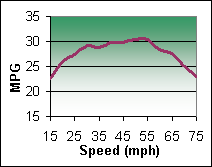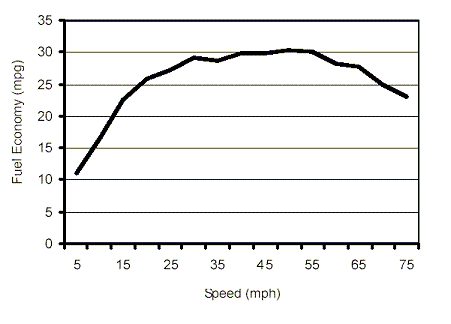Does Driving Slower Save Gas?
By Kevin
Michelle Singletary advises that to save on gasoline, we should, among other things, slow down.
Stop speeding. The faster you drive, the more gas you use, the more money you spend. Each 5 mph over 60 is equivalent to paying an extra 10 cents per gallon for gas....I'm not going to discuss the time cost of slowing down. For arguments sake, assume that you're indifferent between sitting at home or sitting in your car. Is it true, regardless of your car make, model, and condition, that driving 65 instead of 60 increases average fuel cost by about 10 cents per gallon? I'd say yes, with anecdotal caution.Avoid aggressive driving and quick starts and stops. At highway speeds, you'll lower your gas mileage by about 33 percent. By maintaining a constant speed and driving sensibly, you could save as much as 50 cents a gallon.
It seems about right, but only if gas prices are about $2.50 per gallon. This is confirmed by a casual analysis of the graphics provided by the government.
fueleconomy.gov reuses the following graphic without explanation of sources or methodology:

Assume this graph represents an average automobile. That line conveniently peaks at 55MPH, which seems to be the government's consensus estimate for "most efficient". But the government sometimes uses an extended graphic in it's reports:

This graph has the same long plateau, a drop in efficiency from 55 to 60, and a much smaller drop from 60 to 65. It looks to me like driving 60 MPH saves you 1 MPG compared to driving 65 MPH. 1 MPG/26 MPG = ~4% increase in efficiency, or about 4% less fuel needed to drive the same mile. At $2 a gallon, this saves us 8 cents per mile.
But including speeds from 0 to 15 on the left makes fast highway driving look very favorable to slow log-jam traffic. It's more fuel efficient to speed home early than to sit in rush hour parking lots.
But an honest examination of fuel efficiency must conclude that the optimum fuel efficiency speed is not easily calculated, although the "sweet spot" is usually somewhere between 40 and 60 miles an hour, depending on the type and configuration of each car, and weather conditions.
Confirming the chart's line: In my wife's Volvo V40, I averaged almost 30 MPG driving at 65 MPH up and down I-95. I found that there was no perceptible difference in fuel efficiency between cruising at 60 and cruising at 65.
Comments